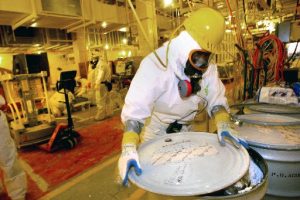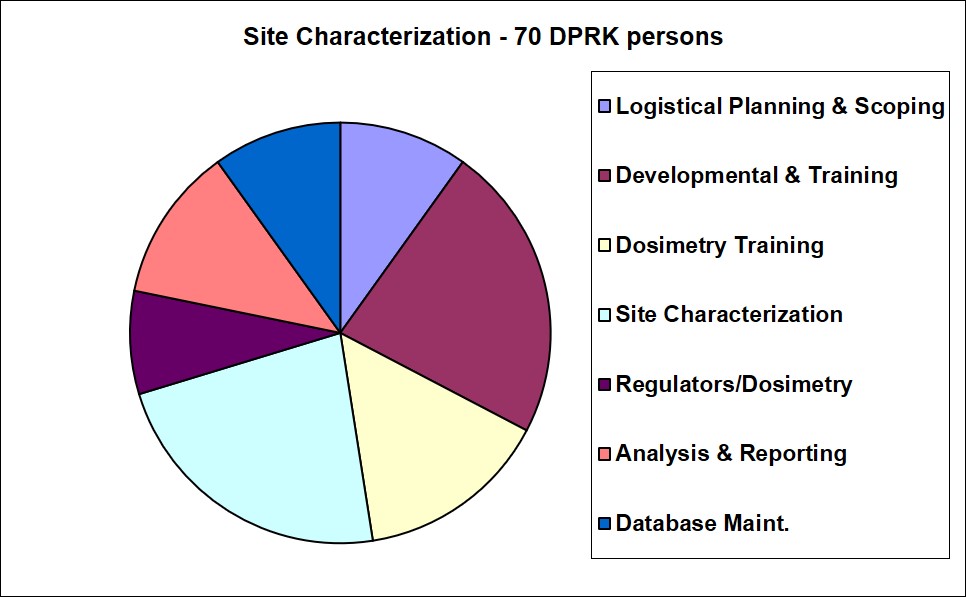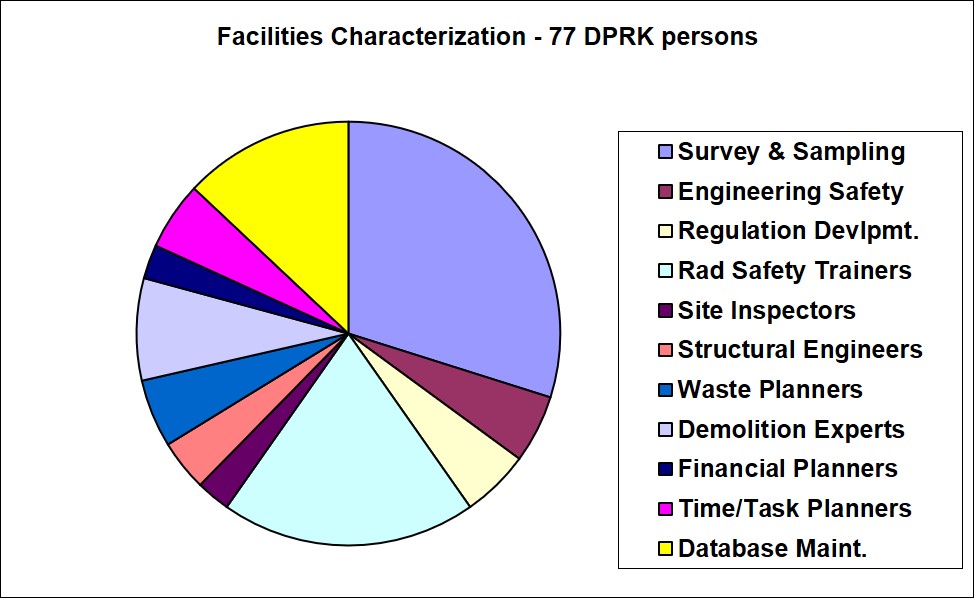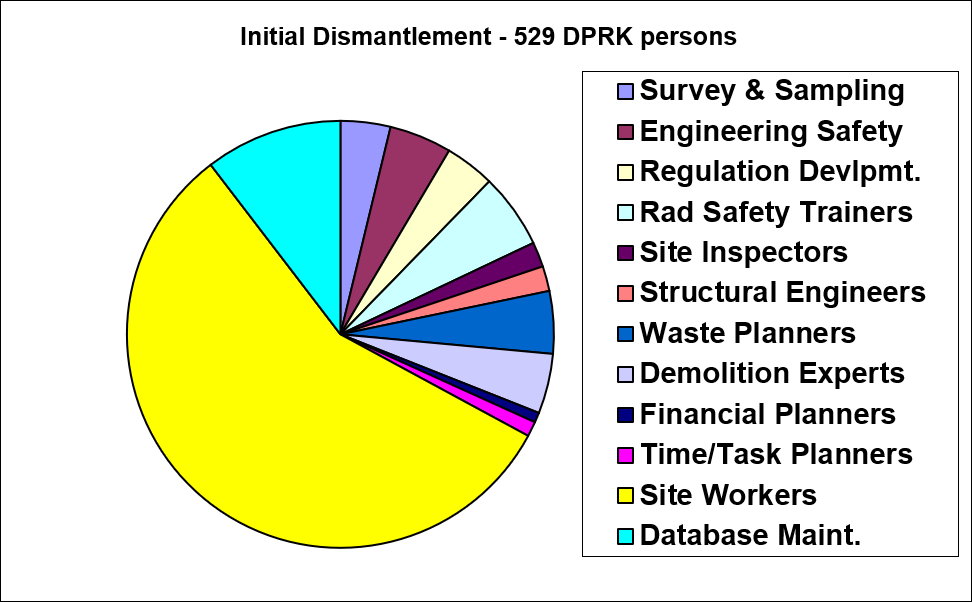A How-To Guide for Disabling and Dismantling Yongbyon

With another summit between US President Donald Trump and North Korean leader Kim Jong Un scheduled for February 27-28 in Vietnam, the potential dismantlement of North Korea’s Yongbyon Nuclear Scientific Research Center looms as a first step towards denuclearization of the Korean Peninsula. In his September 2018 Pyongyang summit meeting with South Korean President Moon Jae-in, Kim expressed his willingness to dismantle Yongbyon if the United States took corresponding measures. The dismantlement would still leave North Korea with a nuclear weapons stockpile and the ability to produce additional weapons based on the production of highly enriched uranium (HEU) elsewhere. But it would represent an important step towards denuclearization since it would end the North’s production of plutonium and hinder the overall production of HEU.
If an agreement to dismantle Yongbyon is reached, implementation will pose enormous political, technical and financial challenges. It would require US-DPRK agreement on a game plan including the possible involvement of other actors such as South Korea, China, Russia, the IAEA and perhaps the European Union. The objective will be to quickly disable, dismantle and decontaminate the plutonium reprocessing facility, the uranium enrichment plant, and the 5 MWe reactor as well as to safely dispose of spent and enriched fuel and nuclear waste products. It will also be necessary to make sure that North Korean personnel involved in the operation of those facilities are not reemployed in Pyongyang’s nuclear weapons program.
Disablement/Dismantlement of Plutonium Recovery and Uranium Enrichment Facilities
Based on previous experience, all options for disablement and dismantlement of the plutonium recovery facilities, uranium enrichment cascades and IRT research reactor will require years of work and millions if not billions of dollars. For example:
- Rocky Flats: Remediation of the US plutonium recovery plant at Rocky Flats was completed over 14 years at a cost of $7-$10 billion. Rocky Flats, however, involved the demolition of 802 structures and remediation of hundreds of acres of contaminated soil. Over 500,000 cubic meters of radioactive waste was characterized, packaged and transported to radioactive waste repositories off-site. The cost and scope of cleanup at Yongbyon will be far less because it has thousands of fewer acres to remediate and many fewer structures to dismantle. For example, the estimated amount of time required to disable and dismantle Yongbyon’s reprocessing plant is 8-12 years at a cost of $525 million-$1.5 billion, significantly less than Rocky Flats’ 14 years of work totaling roughly $7.7 billion.
- Belgium: Developing effective and thorough decommissioning techniques for Eurochemic took precedence over urgency. The process took 25 years to complete at a cost of $333.75 million. During that time, nuclear waste and sludge were treated, buildings were demolished, and a research reactor decommissioned. There are far fewer process cells, however, to decommission at Yongbyon and far less area that requires decontamination. Eurochemic’s decommissioning cost is at the lower end of the estimated cost for Yongbyon, but it already had waste storage processes and facilities. These would need to be built and tested at Yongbyon, adding to the cost and processing time. Nonetheless, the experience at Eurochemic can help illustrate effective methods and processes.
Three key variables will determine the length of time and cost of disabling and dismantling the Yongbyon facility.
1. The End-Use Objective
The extent of remediation and cleanup needed subsequent to the disablement and dismantlement of facilities will dictate the methods, duration and ultimate costs of the decommissioning process. There are three common end-use options:
- Unrestricted Use: This requires sufficient cleanup to prevent annual radiation doses from exceeding safety standards for the general population for all onsite activities. Since reduced radiation doses will require the transfer of contaminated materials to waste storage facilities, this status will usually cost more and require greater remediation times than the other options.
- Industrial Use: This would restrict access and use of the area to trained personnel. Restrictions may involve protective measures, regulated exposure times and limited access to regions with unacceptable exposure rates.
- Radiation-Controlled Area: Time and budget constraints, physical inaccessibility, and inadequate equipment or storage may prevent timely remediation. In these cases, conducting minimal cleanup may only be possible, leaving remaining radiation exposures that are unacceptable for normal human activities. Specific and detailed procedures will need to be followed in these areas to limit radiation exposure.
2. The Timing and Extent of Site Characterization and Remediation
Dismantlement of facilities requires comprehensive knowledge of structural challenges, threats to worker and public safety during dismantlement procedures, probable waste volumes, avenues of transport, and workforce required to perform the tasks. Potential health hazards caused by radioactive contamination and standard regulatory practice for nuclear dismantlement will require a thorough site characterization prior to accepting site safety and remediation plans. The characterization would identify potential safety hazards, radiation exposures and alternative dismantlement methods necessary to minimize health risks for workers during dismantlement and future activities at the site. It would also estimate waste stream volumes and processes required to meet the decided end-use objective. Specific work plans are developed to reduce safety concerns to the lowest possible level.
However, many potential hazards and radioactive sources may not be readily identified prior to dismantlement. In such cases, structural dismantlement and material characterization may be conducted simultaneously in a staged process.[1] Most regulations also require a post-dismantlement site characterization to document that all hazards have been minimized and that end-use objectives have indeed been fulfilled.[2] If the process of site and facilities characterization were to use DPRK workers, the below chart gives an estimate of the number of workers needed and in which sectors the North Korean workers could be utilized.[3]


3. The Amount of Foreign Involvement in the Project
It will be critical to clearly establish which nations and agencies will participate in the disablement, dismantlement, regulatory oversight and advisory activities. The most efficient, but perhaps the costliest process for the US would be to make disablement and decommissioning of Yongbyon facilities a bilateral US-DPRK undertaking. While bilateral participation could expedite nuclear disablement measures, it may be necessary to include international partners to help in sharing the costs. Other nations and international actors, including South Korea, China, Russia and the IAEA could participate in one of the following capacities:
- Strictly advisory, providing recommendations for work plans, regulatory objectives, and/or verification;
- Educational, assisting in redirection training given to Yongbyon workers; or
- Participatory, as full partners in all dismantlement and disposal procedures.
Including DPRK scientists and administrators in all processes of safe disablement, dismantlement and disposal of critical facilities will introduce personnel to international agencies and acceptable standards for future actions.[4]
Disablement and Dismantlement Options
The choices above are not necessarily independent of one another. For example, unrestricted end-use is unlikely to result from rapid disablement and minimal site characterization. Likewise, maximal retraining of key personnel may not be feasible without thorough site characterizations, extensive onsite presence of international experts, and full IAEA technical cooperation.
These trade-offs will need to be carefully considered. The US and allies would likely benefit from rapid disablement to meet their short-term objectives, followed by long-term training and onsite verification. North Korea, on the other hand, may suggest gradual completion of retraining and incentive programs prior to an autonomous process of dismantlement and disposal. There are some possible compromises which would allow short-term nonproliferation assurances and retraining of hundreds of key personnel while delaying major portions of dismantlement and disposal until well into the future.
A. Rapid Disablement and Dismantlement
A large team of experts from the United States would be required to implement this option in compliance with international standards.[5] Rapid disablement can be achieved by filling glove boxes with concrete, removing remote manipulator arms from hot cells, defueling reactors and flooding cooling circuits, steam generators and reactor vessels with concrete.[6] Similar disabling tactics were employed by IAEA inspectors in post-Desert Storm Iraq (although the reactors were disabled by coalition bombing).[7] Nuclear reactors may be further disabled by coating vessel components with neutron absorbing materials such as boron. Uranium enrichment processes are more readily dismantled with less exposure to hazards than plutonium processes. Plasma torches could quickly compromise control rooms and centrifuge functions and disrupt cascade integrity. Nevertheless, skilled technicians would be required for cutting concrete and pipe, removing circuitry, and packing and transporting hazardous materials after disablement.
Given the necessary resources, manpower and prior planning, the primary facilities for uranium enrichment and plutonium recovery could be rendered useless in less than a year at a cost of about $4-6 million. At the end of disablement, the facilities would still require careful and prolonged dismantlement to render the areas safe and ready for alternative uses. Rapid disablement would likely complicate subsequent dismantlement of concrete-filled structures. Moreover, the use of concrete will reduce effectiveness of waste minimization, thereby increasing the volume of radioactive waste. Therefore, cost savings realized by quick disablement would likely be offset by higher costs and prolonged time for dismantlement and waste processing over the long-term. Implementation would require the rapid deployment of a team of 50-75 American specialists.
This option could also include defueling and disabling the 5 MWe reactor, which is the source of plutonium generation. Of course, this procedure would be carried out only after rejecting any consideration for refurbishing the reactor for peacetime purposes. Ultimate dismantlement of the reactor facility would be delayed allowing a gradual schedule that permits IAEA oversight and inclusion of DPRK personnel. The rapid disablement by defueling and compromising primary and secondary coolant circuits would cost about $3 million (including transport of reactor fuel rods), while subsequent dismantlement and disposal of the structure would be an additional $20-$30 million. The total costs for rapid disablement followed by dismantlement and disposal of the plutonium recovery facilities, uranium enrichment centrifuges, and the IRT reactor would range from $250 million to $1.5 billion. Disablement and dismantlement under IAEA supervision would take 10-20 years at a cost of $525 million-$1.5 billion; without IAEA supervision, 4-10 years and $250 million-$1 billion.
B. Disablement and Delayed Dismantlement
It may be advantageous to delay the dismantlement of some structures, allowing time for the decay of radioactivity to safe levels for removal and disposal. Neutron-activated materials in reactor vessels and contaminated interiors of hot cells may pose high risks initially, but these will diminish significantly over time. In such cases, the structures may be isolated and surrounded (“cocooned”) by a thick shell of impermeable concrete. The cocooned structures can be more readily removed from the shells after many years and then disposed of in conventional storage facilities. Cocooning has become a common practice for reactor vessels and the projected delay time may be 75-100 years.[8] This procedure would eliminate the high costs of dismantling and storing very radioactive materials. Disablement and partial dismantlement would then be followed by a projected period of sequestration of the remaining structures.
The presence of isolated cocoons would probably require “highly restricted” use of the surrounding area. Thus, this option may not be favored at Yongbyon if the area is projected for future public or industrial uses. Also, the initial cost savings may be offset by very expensive dismantlement and disposal at the end of the isolation period. The process of disabling, partial dismantlement, and cocooning Yongbyon’s 5 MWe reactor would cost about $40-$60 million and take over 4-5 years; the subsequent post-cocooning dismantlement and disposal cost would be between $100 and $200 million
C. Traditional Disablement and Dismantlement
This option would place greater emphasis on adhering to international norms than on achieving rapid progress, requiring a slower, steadier process of disablement and dismantlement. One significant difference between this approach and option one, which would immediately begin work on disablement and dismantlement, is that a much more extensive effort would be made up-front to characterize the radioactive contamination of the facility before any work began. These procedures would include training of North Korean participants and would establish detailed work and safety procedures to be followed throughout the subsequent dismantlement process. All three options would follow international standards but this option places greater emphasis from the very beginning on building a multilateral team and developing North Korean participation.

Under this option, the IAEA would be brought into the process at the outset to help establish technical credibility, increase transparency and provide dismantlement training to indigenous experts.[9] This would take much longer, but would reduce costs and liability and safety concerns. Cost and timelines may vary considerably depending on the extent of work performed by indigenous workers and the amount of training required. This approach may prove incompatible, however, with achieving rapid disablement and moving forward quickly on dismantlement, which could be one of the US highest priorities. Of course, US and foreign partners would be needed onsite to verify that agreed standards and conditions are met. This option would be the most expensive and prolonged alternative, requiring 5-20 years and $400 million-$2 billion.
Other Considerations
There are three other important dimensions to disablement and dismantlement that will drive costs, timelines and outcomes.
Disposition of Radioactive Waste
Any dismantlement option will require updated facilities for the treatment and long-term storage of radioactive wastes generated by the operations at Yongbyon. Remaining spent fuel and control rods may be returned to the supplying countries or purchased for export to secure storage facilities. Temporary storage of wastes may be accomplished by importing caravans while permanent facilities are designed and constructed. It is anticipated that completion of a radioactive waste treatment and disposal facility will cost in excess of $200 million and require 4-8 years for site selection, design and construction.
Environmental Remediation
The disablement and dismantlement of Yongbyon will not only focus on the reprocessing and enrichment facilities, but must also address the environmental contamination. Environmental remediation could encompass more than site cleanup and waste disposal, due to North Korea’s long history of poor land-use including forest management, agricultural practices and water and air pollution. Including environmental remediation in the dismantlement process for unrestricted use would require additional planning, time and money. Thus, this option may not be financially feasible for the US or other international actors, and end use may remain either highly restricted or limited to industrial activities.
The Scope of Cooperative Threat Reduction
The disablement and dismantlement process at Yongbyon would provide many opportunities for various incentive and redirection programs for North Koreans who currently work at the site. These programs should be integrated into a wider discussion of dismantlement and nonproliferation objectives from a long-term perspective. The North Korean government has expressed interest in re-allocating resources from the military to the civilian sector. A robust US-DPRK cooperative threat reduction program, with multinational involvement where it is cost effective, offers tremendous potential for civilian spinoffs that would boost North Korea’s economic development and raise the living standards of the population.
Turning Swords into Plowshares
The development of civilian spinoffs could begin in parallel with the disablement and dismantlement process. The Yongbyon facility and its workers could potentially support activities such as:
Improving Health and the Environment
Setting up a medical diagnostics center onsite can initially focus on worker safety at Yongbyon and then expand over time to provide the regional population with medical practices to diagnose patient health and a medical treatment branch for common and debilitating conditions. For example, it could support hospitals and medical practitioners by helping to provide laboratory analysis of blood, urine and tissues, as well as x-rays and other medical imaging. Mobile laboratories could provide these examinations and laboratory diagnostic services on a regular basis. Another possible role would be to maintain medical databases in support of public health and forecasting conditions, as done by the Centers for Disease Control in the United States. This would help set the stage for modernization of health care records and a better understanding of the medical needs of the North Korean people.
Along with creating indigenous infrastructure for medical monitoring for radiation detection and worker safety, the process could also develop a national environmental management laboratory that would initially focus on mitigating radiation exposures and impacts. Over time, the laboratory could grow to include water, soil and air quality assessments, along with forest, biodiversity and agricultural management practices.
Center for Energy Modernization
North Korean scientists and technicians would be trained on topics such as energy surveys and needs assessments, national energy supply-demand modeling, energy efficiency analysis methods and practices (including green buildings), renewable energy systems, up-to-date electricity transmission and distribution systems and other subjects relevant to a modern energy system. Initially, training would be provided by foreign experts (for example, from China, the European Union, Australia and the United States) with North Korean staff eventually training others using the upgraded Yongbyon center as demonstration facilities.
A key goal would be to provide workers with alternative, sustainable employment through the center’s nationwide activities, and possibly through exporting services to other countries at a later time. Second, the center could serve as a research and development institute to develop or adapt designs for key energy efficiency and renewable energy devices with the goal of establishing enterprises in the North to manufacture such devices. It could eventually become the equivalent of a North Korean national laboratory. American organizations (including national laboratories) have worked with local officials in China and Eastern Europe to establish similar institutions.
Conclusion
The decommissioning of nuclear facilities at Yongbyon can take a number of different paths, each offering different end-use objectives, costs, timelines and opportunities for continued nonproliferation programs with North Korea. Decisions on the objectives, remediation methods and training and cooperative programs will determine the methods of dismantlement and disposal necessary to meet those goals. A wide array of experiences in nuclear dismantlement that allow realistic estimates of costs, manpower and time commitments needed to achieve different dismantlement objectives. Negotiations on reducing North Korea’s capacity to produce fissile materials should elucidate the details of nuclear decommissioning and not leave underlying steps open to interpretation. Once the approaches for nuclear dismantlement have been successfully negotiated, attention should be focused on technical developments that will assist North Korea to improve and sustain the quality of life of its population. The more robust economic stimulus programs discussed here will require, however, greater North Korean integration with the global economy and comprehensive contributions from international partners.
- [1]
This procedure was followed in the dismantlement of former nuclear facilities in Iraq destroyed by coalition bombing.
- [2]
In rare circumstances, urgency may dictate an abbreviated site characterization followed by disabling or cocooning procedures that leave most contaminated materials in place for a prescribed period of time. Such cases obviously forego traditional regulatory oversight, but may be dictated by political expediency, severe financial constraints, or uncertain proliferation threats best addressed by rapid disablement of critical facilities while the window of opportunity is open.
- [3]
One option that can minimize time constraints and financial commitments is cocooning. This process delays dismantlement of some high-risk areas until radiation levels have diminished sufficiently to allow safer handling, transport and storage of the remaining contamination. The high-dose areas are typically sequestered using thick concrete barriers and are not scheduled for dismantlement and disposal for 75-100 years. Therefore, high-risk work plans and costly disposal/transport solutions may be postponed or circumvented altogether. Remaining low-risk activities for disablement and dismantlement can take place in accordance with traditional methods. While an unrestricted end-use objective is unlikely with this option, all methods of site characterization and all personnel combinations remain as alternatives for the non-cocooned portions of the facility.
- [4]
Multinational participation has one other significant advantage. It has long been recognized that nuclear nonproliferation must include comprehensive programs to retrain nuclear scientists in alternate, meaningful areas of employment.
- [5]
Nuclear and structural engineers would be needed to identify key components for disablement and to design methods for removal and stabilization of equipment. Disabling plutonium production will focus on radiochemical separations technologies such as hot cells, glove boxes, canyons, and remote manipulators. Electrical circuits can be compromised by removing wiring and processor boards.
- [6]
Concrete is an excellent tool for freezing moving parts in critical tools such as centrifuges, ventilators, valves, pipes, and conveyers and using such tactics could disable plutonium separations and reactor operations in a matter of days or weeks rather than months.
- [7]
Filling glove boxes with concrete is not a recommended method for disablement because it complicates subsequent dismantlement and disposal. IAEA inspectors in Iraq were under severe time constraints.
- [8]
The US Department of Energy cocooned five nuclear reactors at the Hanford Site between 1999 and 2007. The total decommissioning costs for the five reactors was $221.5 million, or an average cost of $21.4 million per reactor. The average completion time of the decommissioning to the point of cocooning was 4.3 years. DOE estimates the post-cocooning costs at Hanford to be about $106 million per reactor. Clearly, cocooning conveys considerable cost and time savings, at least initially.
- [9]
This is the approach that guided Iraq dismantlement programs.
